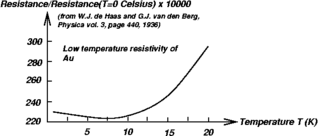
Back Kondo-Effekt German Efecto Kondo Spanish اثر کوندو Persian Kondo-ilmiö Finnish Effet Kondo French Effetto Kondo Italian 近藤効果 Japanese 곤도 효과 Korean Kondoeffekt NN Efekt Kondo Polish


In physics, the Kondo effect describes the scattering of conduction electrons in a metal due to magnetic impurities, resulting in a characteristic change i.e. a minimum in electrical resistivity with temperature.[1] The cause of the effect was first explained by Jun Kondo, who applied third-order perturbation theory to the problem to account for scattering of s-orbital conduction electrons off d-orbital electrons localized at impurities (Kondo model). Kondo's calculation predicted that the scattering rate and the resulting part of the resistivity should increase logarithmically as the temperature approaches 0 K.[2] Experiments in the 1960s by Myriam Sarachik at Bell Laboratories provided the first data that confirmed the Kondo effect.[3] Extended to a lattice of magnetic impurities, the Kondo effect likely explains the formation of heavy fermions and Kondo insulators in intermetallic compounds, especially those involving rare earth elements such as cerium, praseodymium, and ytterbium, and actinide elements such as uranium. The Kondo effect has also been observed in quantum dot systems.
- ^ Hewson, Alex C; Jun Kondo (2009). "Kondo effect". Scholarpedia. 4 (3): 7529. Bibcode:2009SchpJ...4.7529H. doi:10.4249/scholarpedia.7529.
- ^ Kondo, Jun (1964). "Resistance Minimum in Dilute Magnetic Alloys". Progress of Theoretical Physics. 32 (1): 37–49. Bibcode:1964PThPh..32...37K. doi:10.1143/PTP.32.37.
- ^ Chang, Kenneth (August 31, 2020). "Myriam Sarachik Never Gave Up on Physics". The New York Times. ISSN 0362-4331. Archived from the original on August 31, 2020. Retrieved October 13, 2021.
© MMXXIII Rich X Search. We shall prevail. All rights reserved. Rich X Search